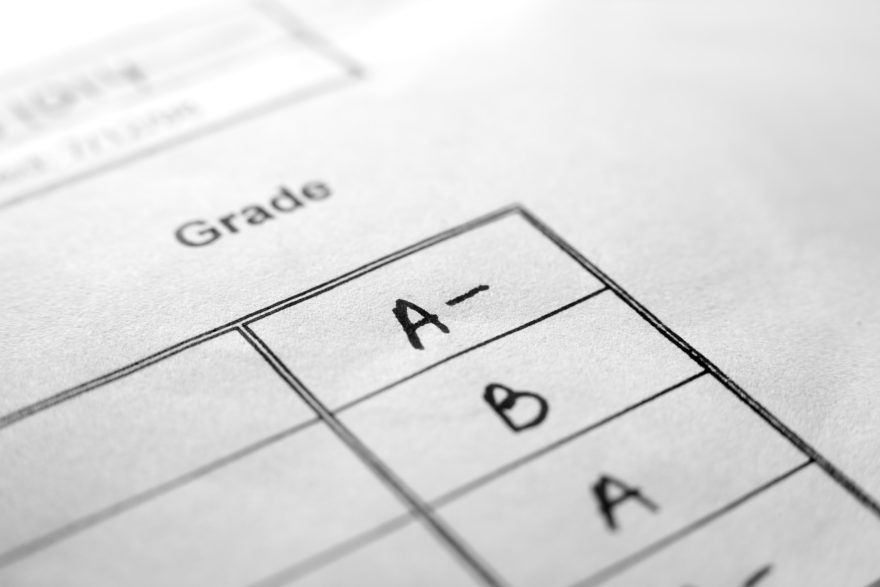- Blog
- > College Admissions
Do Colleges Count Unweighted or Weighted GPAs?


While there are many ways to calculate a GPA, there are two major camps that are crucial to understand in the college admissions process. One is an unweighted GPA, which calculates your overall average grade out of 4.0, without regard to the difficulty of your coursework. The other is a weighted GPA, which reflects both grades and course levels.
So, which is more important? When evaluating a high school student’s academic performance, admissions committees read weighted and unweighted GPAs differently. Read on to learn more about how colleges evaluate your GPAs in the context of applications.
Unweighted GPA
An unweighted GPA is simple to calculate. Each final course grade that you receive (from F to A) corresponds to a grade point out of 4.0, as shown in the table below:
| Letter Grade | Percent Grade | Grade Point |
| A+ | 97-100 | 4.0 |
| A | 93-96 | 4.0 |
| A- | 90-92 | 3.7 |
| B+ | 87-89 | 3.3 |
| B | 83-86 | 3.0 |
| B- | 80-82 | 2.7 |
| C+ | 77-79 | 2.3 |
| C | 73-76 | 2.0 |
| C- | 70-72 | 1.7 |
| D+ | 67-69 | 1.3 |
| D | 65-66 | 1.0 |
| E/F | Below 65 | 0.0 |
Note first that an unweighted GPA cannot average to more than 4.0, which means that there is no mathematical difference between an A and an A+ in unweighted GPAs. Furthermore, not all schools offer the A+, so colleges treat it as identical to an A in unweighted GPAs. Similarly, most colleges consider anything below a D to be a failing grade, so if your school does offer the D- grade, know that it will probably be the same as an F.
Second, notice that an unweighted GPA does not take into account the level of the class. Under this system, an A- in honors or advanced placement course is the same 3.7 as an A- in a lower level class. This erasure is a frequent source of criticism toward the unweighted GPA, and the reasons that many high schools use a weighted GPA instead. Students and parents want their GPAs to reflect the difficulty of their course load in addition to their grades.
What is a Good Unweighted GPA?
A high school transcript that contains an even mix of As and A-s will produce a GPA of 3.85, exactly halfway between the 3.7/A- and the 4.0/A. More As than A-s will come out to a GPA of 3.9 and above, which is generally considered a very high GPA. These are the kinds of numbers that Ivy League schools are looking for. More A-s than As will result in a GPA near or below 3.8, which is still a real accomplishment that colleges will appreciate.
A transcript with a mix of A-s and B+s will produce a grade point average in the range of 3.5, which is an important cutoff for many colleges. In general, admissions officers want to see more As than Bs, so having an unweighted GPA of above 3.5 can make a big difference. A GPA below 3.5 indicates to colleges that you have more Bs than As, and anything below 3.2 suggests that you may have some Cs in the mix, too, which will be a red flag for very selective schools.
That said, even if your high school uses an unweighted GPA, colleges absolutely pay attention to how many honors and AP classes you are taking. Thus, even if your GPA is a lower than a peer who is taking all regular classes, you will still be the more competitive applicant if you’re taking more honors classes. The key is balance: take challenging courses, but don’t tank your grades. No number of difficult classes can make up for a poor unweighted GPA.
Weighted GPA
A weighted GPA, on the other hand, is a figure that purports to represent both how well you did in each class as well as their overall course difficulty. The trouble with weighted GPAs is that every high school calculates them differently. The most common GPA scale is one in which any grade in an advanced class is increased by a full grade point, as shown in the table below. However, while the 5.0 scale is common, high schools are also known to employ a GPA scale out of 4.5, 6.0, 9.0, or 10.0, among other grading scales.
| Letter Grade | Percent Grade | Honors/AP Level GP | Standard Level GP |
| A+ | 97-100 | 5.3 | 4.0 |
| A | 93-96 | 5.0 | 4.0 |
| A- | 90-92 | 4.7 | 3.7 |
| B+ | 87-89 | 4.3 | 3.3 |
| B | 83-86 | 4.0 | 3.0 |
| B- | 80-82 | 3.7 | 2.7 |
| C+ | 77-79 | 3.3 | 2.3 |
| C | 73-76 | 3.0 | 2.0 |
| C- | 70-72 | 2.7 | 1.7 |
| D+ | 67-69 | 2.3 | 1.3 |
| D | 65-66 | 2.0 | 1.0 |
| E/F | Below 65 | 0.0 | 0.0 |
With a weighted GPA scale, regardless of the upper limit, an A student will have a higher GPA than 4.0. Any grade point average above 4.0 will indicate to colleges that the high school uses a weighted GPA scale, as such a number is impossible in an unweighted system.
What is a Good Weighted GPA?
That question is extremely hard to answer because of the variance in GPA scales used by different high schools, as well as the different class levels available at different high schools. In general, a student aiming for the most selective schools should aim to have a GPA as close to the maximum as they can manage. That is, if the GPA scale is out of 4.5, they should have a 4.4 or higher, a 4.9 or higher for a 5.0 scale, and so on. Just as with unweighted GPAs, admissions officers are looking for good grades in upper level courses.
Sometimes weighted GPAs can be hard to understand, because different high schools may weight honors courses differently, or they may cap how many AP courses a student can take. If you have questions about how your high school’s weighted GPA is calculated, you can always talk to your guidance counselor or another school official.
Which Do Colleges Look At: Weighted or Unweighted?
First, know that admissions committees are not fooled by weighted GPAs! Based on school reports, conversations with guidance counselors, and previous knowledge of the applicant’s high school, admissions officers know whether they’re looking at a weighted or unweighted GPA, and will only compare like with like. So, if your school provides only an unweighted GPA, don’t worry that your 3.9 will look worse than someone with a 4.3 weighted GPA.
In fact, to get around this, many colleges actually recalculate all applicant’s GPAs so that everyone starts from the same page: an unweighted GPA of just major courses (i.e., science, math, English, history, and foreign language). This means excluding non-academic classes like physical education from their academic evaluation. By doing this, admissions committees can more easily compare applicants’ GPAs before further examining how many challenging courses the student took.
Another thing colleges sometimes ask about is class rank, which is determined by GPA. Class rank used to play a big role in college admissions, but more recently it has fallen out of favor. Many educators argue that ranking fosters cutthroat competition among students, when in fact precise enumeration does not mean as much to colleges as overall academic performance. For this reason, many high schools now report decile instead of rank, while some provide no comparative measure between students at all. Rankings that use weighted GPAs reflect students’ efforts in challenging courses, while those using unweighted GPAs do not.
Additionally, know that most colleges do not have official GPA requirements for admission, because grades can vary so much by student and by high school. The GPA is a starting point for college admissions officers to begin evaluating a student’s overall academic performance, but it is not the only factor. They always seek to contextualize those grades in your larger profile.
Final Thoughts
Finally, remember that while your GPA matters, the rest of your college application is also extremely important. In addition to your GPA, admissions officers will look at your standardized test scores, college essays, extracurricular activities, and your scores on AP exams (not just the grade in the class). College admissions is a largely holistic process, so any one factor can offset another. For example, if you have a very high GPA but somewhat lower test scores, that can signal to colleges that you’re smart but not a stellar test-taker. Vice versa, and they know you have innate intelligence but may struggle in certain classroom settings.
Overall, knowing where your GPA falls relative to college admissions officers’ expectations is critical in creating a balanced list of schools to apply to, knowing what courses to take at your high school, and strategizing about how much time you should spend on schoolwork versus extracurricular activities. Most colleges take all your grades into account, including senior year, so it’s never too late to move the needle!
Subscribe to our newsletter for college admissions news
Related articles from the Spark Admissions blog

Which Colleges and Universities Will Be Test-Optional in 2023-2024?
Here is an up-to-date list of every school that will be test-optional, test-flexible, or test-blind in 2023-2024.
Categories: College Admissions
Read More
Surprising Admissions Trends at U.S. Colleges in 2021-2022
This spring, many students and families discovered that schools that could once have been considered relatively safe bets for strong students were no longer sure things. Here, we’ve highlighted some of the schools that saw a particularly noteworthy drop in their admission rates.
Categories: College Admissions
Read More
Changes in Admission at Top Boston-Area Schools
In recent years, colleges and universities in and around Boston (including those in its neighboring suburbs) have received a growing number of applications, and as a result, falling admission rates.
Categories: College Admissions
Read More